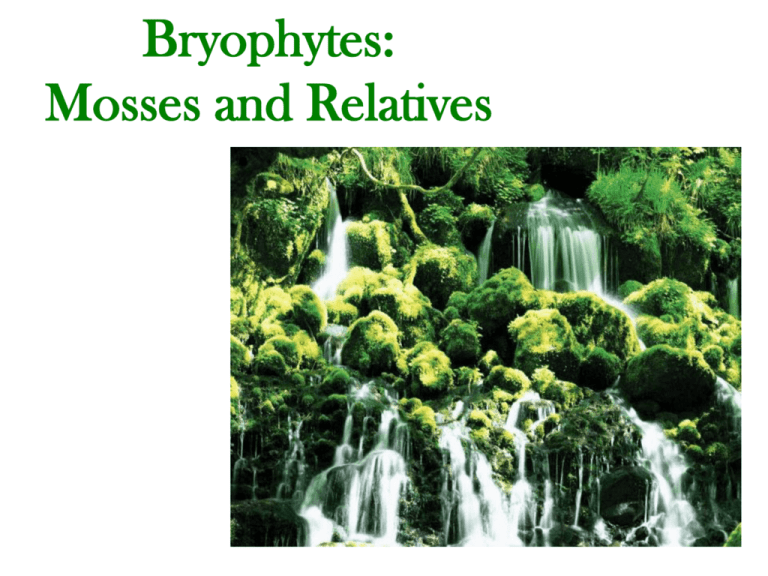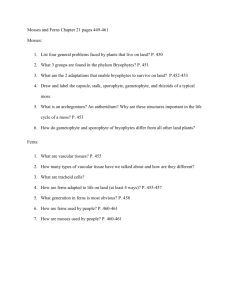CB098-008.23_Bryophytes
advertisement

Bryophytes: Mosses and Relatives Bryophytes The term “Bryophyte” is not a strict taxonomic category. It includes the mosses and mosslike relatives (liverworts and hornworts). Bryology – the study of moss and moss-like relatives. Byrophytes – a group of small, mainly terrestrial plants that have an embryo life cycle phase but lack vascular tissue; contains mosses, liverworts and hornworts. Bryophytes are arguably the most primitive plants in the Plant Kingdom. They are the first land plants to arise. In variable climates, bryophytes are dormant much of the year. Epiphytic mosses on trees. Bryophyte Facts - 25,000 named bryophyte species. - Extremely widespread (Extreme cold to very hot), being present on all continents. This includes Antarctica. - No lignin present. Remember that lignin is found in many plant cell walls, provides strength for wood and it is necessary in support of tall plants. Therefore, bryophytes are small. - No Vascular (Xylem/Phloem) Tissue. Therefore, bryophytes absorb water by diffusion. They are often restricted to moist habitats. Mosses are the green, carpet-like plant seen growing in damp forests, sometimes on fallen logs. A Cladogram or Relationships Between the Bryophytes & the Vascular Plants. Bryophyte Divisions Division Bryophyta Division Marchantiophyta Division Anthocerotophyta Stomata and Cuticle (protective layer) first appear in bryophytes. Cuticle doesn’t cover entire bryophyte because they absorb much water and minerals through their dermal layer. Bryophytes appeared around 475 million years ago. The Gametophyte Dominates the Life Cycle If you remember from the life cycles chapter, the gametophyte is the gamete producing plant. It is n (haploid) and it produces and holds the gametes. The sporophyte is the 2n (diploid) plant body. Like all plants, bryophytes exhibit alternation of generations. In bryophytes, the gametophyte (multicellular) is dominant and persists for most of the plant’s life. The sporophyte (multicellular) is short-lived. It grows from an embryo embedded within the mature gametophyte plant and is dependent on the gametophyte for its nutrition. The unbranched sporophyte produces a single sporangium. The moss, Mnium, showing both sporophyte & gametophyte generations. Gametangia and gametes can be embedded in the gametophyte tissue as shown here, or attached at the surface of the gametophyte. Gametangia – organs that produce gametes. Archegonium (Egg-bearing Organ) with a long neck extends beyond the venter, capped at the tip with cover cells. Note: Unlike algal ancestors, bryophytes have multicellular gametangia. Antheridium (Sperm-bearing Organ) with an outer row of sterile (nonspermforming) cells enclosing inner fertile cells, each of which becomes a sperm gamete. General Bryophyte Life Cycle Description A haploid (n) spore settles on the moist ground, germinates and develops by mitosis into a threadlike, haploid protonema (early gametophyte stage) from which individual gametophytes arise like branches. The gametophyte derives its nutrients from photosynthesis. Archegonia and antheridia, structures that produce eggs and sperm, respectively, develop on the tips of the gametophyte. The zygote (2n) develops into the sporophyte, a diploid adult, which is a filament that grows out of the top of the gametophyte. Out of the tip of the mature sporophyte sprouts sporangia (Singular, Sporanguim). Sporangia are where spores are made. In sporangia, meiosis occurs, producing haploid spores and the entire life cycle begins again. See Next Slide. Water is very important in fertilization. Sperm (flagellated) must swim through water to fertilize an egg. Life Cycle of Polytrichum, a typical moss. Hornworts Division Anthocerotophyta Hornworts often have long, pointed sporophytes (resembling horns) that rise from the thalloid gametophytes. Liverworts Division Marchantiophyta Liverworts look like liver. They were used as medicine to help the liver in the middle ages in Europe because of this. Mosses Division Bryophyta Bryophyta includes the most bryophyte species. This division includes the true mosses, granite mosses and peat mosses. The Sphagnum genus is an important peat moss. It is used in potting soil for better water-holding capabilities. Gametangia of Mnium, a moss that produces antheridia and archegonia on different heads but on the same plant. Bryophyte Ecology and Human Use Bryophyte gametophytes are not able to control their water balance and they dry out rapidly in the absence of free water but some can be drought resistant and come back and thrive with water. Bryophytes play a significant role in diverse terrestrial ecosystems. They grow on soil, rocks and trees. Wetland moss, sphagnum or peat moss is especially widespread, forming deposits of peat, commonly used as fuel in much of the world. In addition to its role as a fuel, peat moss is added to soil to enable it to retain moisture or as a packing material for transporting plant roots. Bryophytes are very important in many ecosystems and moss makes up much of the biomass in boreal tundra vegetation. Bryophytes often dominate understory vegetation in cool temperate (not too hot/not too cold) forests. Most cool microenvironments have bryophytes. Some bryophyte species can colonize dry areas. BIO 141 Botany with Laboratory • This product is sponsored by a grant awarded under the President’s Community-Based Job Training Grants as implemented by the U.S. Department of Labor’s Employment and Training Administration. The information contained in this product was created by a grantee organization and does not necessarily reflect the official position of the U.S. Department of Labor. All references to non-governmental companies or organizations, their services, products, or resources are offered for informational purposes and should not be construed as an endorsement by the Department of Labor. This product is copyrighted by the institution that created it and is intended for individual organizational, non-commercial use only.









